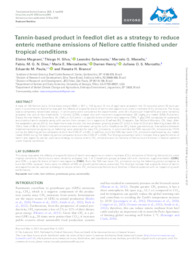Tannin-based product in feedlot diet as a strategy to reduce enteric methane emissions of Nellore cattle finished under tropical conditions.
Tannin-based product in feedlot diet as a strategy to reduce enteric methane emissions of Nellore cattle finished under tropical conditions.
Author(s): MAGNANI, E.; SILVA, T. H. da; SAKAMOTO, L.; MANELLA, M. de Q.; DIAS, F. M. G. N.; MERCADANTE, M. E. Z.; HENRY, D.; SANTOS, J. de O.; PAULA, E. M.; BRANCO, R. H.
Summary: Abstract: A total of 120 Nellore bulls, [initial body weight (BW) = 307 ± 11.6 kg and 12 mo of age] were allocated into 12 collective pens (10 bulls per pen) in a commercial feedlot to evaluate the effects of a specific blend of tannin and saponins on enteric methane (CH4) emissions. The study was a completely randomized design, in which pens were considered the experimental units (N = 6 pens per treatment) and were randomly allocated into one of two treatments: 1) Control (CON), a basal diet with monensin supplementation (25 mg/kg dry matter [DM]; Rumensin, Elanco Animal Health, Greenfield, IN, USA), or 2) Control + a specific blend of tannin and saponins (TAN; 7 g/kg DM; composed of quebracho and chestnut tannin extracts along with carriers from cereals rich in saponins; SilvaFeed BX, Silvateam, San Michele Mondovi, CN, Italy). After the adaptation period (20 d), the experiment was divided into two phases: growing phase (21 to 53 d; total of 33 d) and fattening phase (54 to 139 d; total of 86 d). Enteric methane emissions were estimated using the sulfur hexafluoride (SF6) tracer gas technique. Interactions between treatment and period (growing vs. fattening) were detected for daily CH4 emissions, in which animals fed TAN reduced CH4 emissions by 17.3% during the fattening period compared to bulls fed CON (P = 0.05). In addition, bulls fed TAN had lower CH4 emissions expressed by dry matter intake (DMI) during the fattening period compared to bulls fed CON (P = 0.06). The findings presented herein indicate that a specific blend of tannin and saponins can be used as a strategy to reduce enteric CH4 emissions and its intensity of Nellore bulls finished in feedlot systems under tropical conditions.
Publication year: 2023
Types of publication: Journal article
Unit: Embrapa Environment
Observation
Some of Embrapa's publications are published as ePub files. To read them, use or download one of the following free software options to your computer or mobile device. Android: Google Play Books; IOS: iBooks; Windows and Linux: Calibre.
Access other publications
Access the Agricultural Research Database (BDPA) to consult Embrapa's full library collection and records.
Visit Embrapa Bookstore to purchase books and other publications sold by Embrapa.

